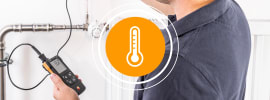The testo 6446 compressed air meter enables you to carry out accurate compressed air consumption measurements, consumption and leak monitoring and flow measurements in your compressed air system. The compressed air meter can also be used to carry out a peak load analysis in order to determine whether you are generating compressed air of sufficient capacity. Overall, these measures can help you find potential for savings or prevent unnecessary investment costs.
Overview of the technical advantages offered by the testo 6446 compressed air meter
The testo 6446 compressed air meter is also a transmitter, which converts the measured parameter into a standardized electrical signal. The transmitter can therefore be integrated into systems (e.g. compressed air systems), making it a key instrument in measuring and control technology. The testo 6446 compressed air meter also offers the following advantages:- Ultimate flexibility with a variety of signal outputs: analog output, pulse output, 2 switching outputs. You will therefore be equipped for any kind of application, whether that is consumption measurement, consumption or leak monitoring or even flow measurement
- Integrated totalling function: the practical totaliser means that no additional analysis units are needed to calculate the total consumption
- Flexible mounting: with measuring block, pipe clamp or as a measurement fitting
- Ultimate accuracy: the compressed air meter is available in various sizes (notably larger pipe diameters are covered: DN65-250). At any size the inner diameter is precisely defined, enabling standard volume flow adjustment. You can therefore achieve a high degree of measuring accuracy – particularly in comparison with standard penetration probes, which deduce volume flow on the basis of measured flow and specified pipe diameter and are therefore prone to greater vulnerability to error
- Easy operation with a high degree of flexibility: parametrization of signal outputs, switching of physical units, signal delay, signal attenuation are all possible
- Measurement according to the calorimetric principle: no pressure loss during measurement
- Other advantages: no temperature compensation required, quick response time, robust sensor, optimized accuracy thanks to integrated inflow and outflow sections




























